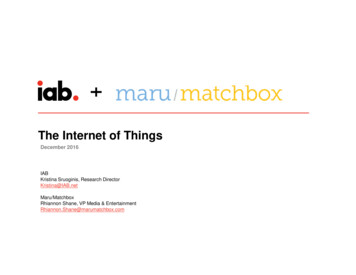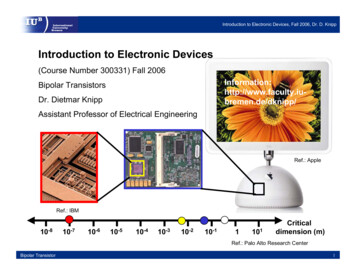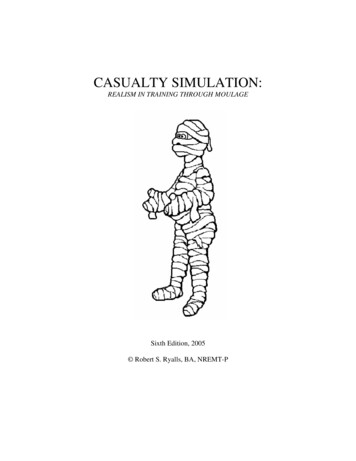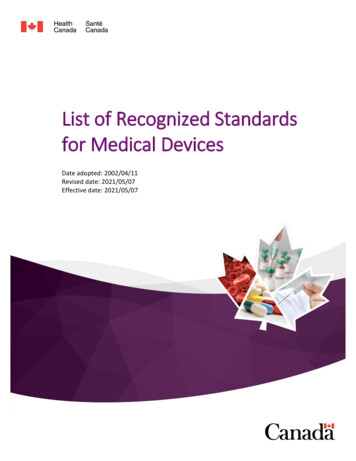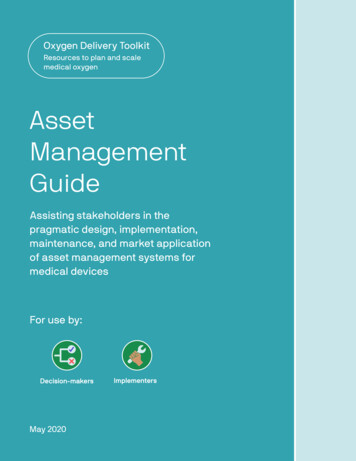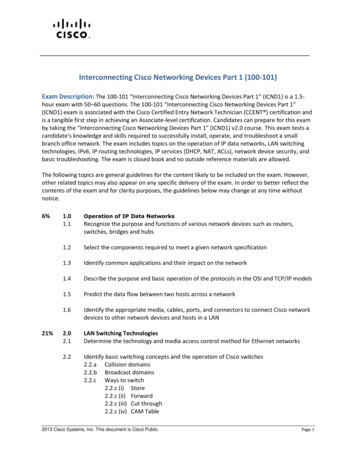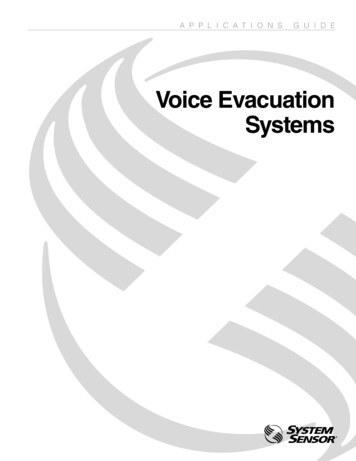
Transcription
Safe ListeningDevices and SystemsA WHO-ITU standard
Safe ListeningDevices and SystemsA WHO-ITU standard
Safe listening devices and systems: a WHO-ITU standardISBN 978-92-4-151527–6 (WHO) World Health Organization and International Telecommunication Union, 2019Some rights reserved. This work is available under the Creative CommonsAttribution-NonCommercial-ShareAlike 3.0 IGO licence (CC BY-NC-SA 3.0 3.0/igo).Under the terms of this licence, you may copy, redistribute and adapt the work for non-commercialpurposes, provided the work is appropriately cited, as indicated below. In any use of this work, thereshould be no suggestion that WHO or ITU endorses any specific organization, products or services. Theunauthorized use of the WHO or ITU names or logos is not permitted. If you adapt the work, then you mustlicense your work under the same or equivalent Creative Commons licence. If you create a translation ofthis work, you should add the following disclaimer along with the suggested citation: “This translation wasnot created by the World Health Organization (WHO) or the International Telecommunication Union (ITU).Neither WHO nor ITU are responsible for the content or accuracy of this translation. The original Englishedition shall be the binding and authentic edition”.Any mediation relating to disputes arising under the licence shall be conducted in accordance with themediation rules of the World Intellectual Property rules).Suggested citation. Safe listening devices and systems: a WHO-ITU standard. Geneva: World HealthOrganization and International Telecommunication Union, 2019. Licence: CC BY-NC-SA 3.0 IGO.Cataloguing-in-Publication (CIP) data. CIP data are available at http://apps.who.int/iris.Sales, rights and licensing. To purchase WHO publications, see http://apps.who.int/bookorders. ITUPublications can be obtained from ITU Bookshop http://www.itu.int/en/publications. To submit requestsfor commercial use and queries on rights and licensing, see http://www.who.int/about/licensing.Third-party materials. If you wish to reuse material from this work that is attributed to a third party, suchas tables, figures or images, it is your responsibility to determine whether permission is needed for thatreuse and to obtain permission from the copyright holder. The risk of claims resulting from infringementof any third-party-owned component in the work rests solely with the user.General disclaimers. The designations employed and the presentation of the material in this publicationdo not imply the expression of any opinion whatsoever on the part of WHO or ITU concerning the legalstatus of any country, territory, city or area or of its authorities, or concerning the delimitation of its frontiersor boundaries. Dotted and dashed lines on maps represent approximate border lines for which there maynot yet be full agreement.The mention of specific companies or of certain manufacturers’ products does not imply that they areendorsed or recommended by WHO or ITU in preference to others of a similar nature that are notmentioned. Errors and omissions excepted, the names of proprietary products are distinguished by initialcapital letters.All reasonable precautions have been taken by WHO and ITU to verify the information contained in thispublication. However, the published material is being distributed without warranty of any kind, eitherexpressed or implied. The responsibility for the interpretation and use of the material lies with the reader.In no event shall WHO or ITU be liable for damages arising from its use.Printed in Switzerland
ContentsAbbreviations and acronymsGlossaryExecutive summaryIntroduction .10Effect of noise on hearing .10What is safe listening?.11Purpose of WHO-ITU H.870 Global standard on safe listening devices and systems.11Development process .12Application and use .12WHO-ITU H.870 Global standard for safe listening devices and systems.14Scope .14Recommendations .15Recommendation 1Recommendation 2Recommendation 3Bibliography .22AppendicesAppendix 1: Dose estimation functionality for implementation in a personal audio system . 26Appendix 2: Example of health communication. 36
Abbreviations and acronymsCSDcalculated sound doseDACdigital to analogue conversiondBAdecibels of sound pressure level measured using the a-weighting networkdBFSdecibel full scaledBHLdecibels of hearing leveldBSPLdecibel sound pressure levelDRPeardrum reference pointLAEQequivalent continuous average sound levelLEXequivalent continuous average sound level normalizedNIHLnoise-induced hearing lossPADpersonal audio devicePASpersonal audio systemPMPpersonal media playerRMSroot mean squaredSIHLsound-induced hearing lossSLDsafe listening deviceSPLsound pressure level
GlossarydBA: Decibels of sound pressure level measured using the A-weighting network; a level intended tomeasure low-intensity noise (around 40 phon loudness level) but has become commonly used alsofor measuring occupational and environmental noise exposures.dBHL: Decibels of hearing level at a certain frequency; a level used to measure audiometric hearingthreshold relative to the level defined as normal.NOTE – It is the ear’s sensitivity in a human with normal hearing, at different frequencies, that is thereference. ISO 226 is a mapping of phon against dB SPL, and the two scales meet at 1 kHz. dB SPL,which is by definition referenced at the threshold of hearing at 1 kHz, i.e. 0 phon (and 0 dB SPL).Sound dose: The total quantity of sound received by the human during a specified period. In thecontext of the WHO-ITU Global standard, it is the same as sound exposure. The unit of (sound) doseis Pa2h.Dosimetry: The calculation and assessment of the sound dose received by a human.Equal energy principle: The assumption that equal amounts of sound energy will cause equalamounts of sound-induced permanent threshold shift, regardless of the distribution of the energyacross time.Equivalent continuous A-weighted sound pressure level: A continuous sound pressure level(SPL) in dBA which is considered to pose the same risk as a time-varying SPL, calculated using a 3dB exchange rate between level and time. Mathematically, it is represented as:t₂L(Aeq,T) 10lg{[1/T t₁ pA² (t)dt] p₀²}dBAwhereLAeq,T is the equivalent continuous A-weighted sound pressure level re 20 μPa, determinedover a time integration interval T t2 – t1;pA (t)is the instantaneous A-weighted sound pressure of the sound signalp (t)0is the reference sound pressure of 20 μPaEquivalent continuous average sound level normalized: A continuous SPL in dBA which isconsidered to pose the same risk as a certain time-varying SPL pattern measured using a 3 dBexchange rate, and normalized to an n-hour exposure period. Examples of the values for n is 8, inwhich case this may also be referred to as an LA8hn or LEX8h", or n 40, LEX40h.Exchange rate: The change in average noise level (in dB) that corresponds to a doubling or halvingof allowable exposure time.Frequency response: In this context, frequency response is short for “sensitivity vs. frequencyresponse”, sometimes referred to as the “tone curve” of an audio device, such as a headphone,loudspeaker, microphone, amplifier etc.
Listening device: A device used to transmit sound to the ear. Consists of a transducer and fitting toaccommodate in the ear, on the ear or over the ear listening. Examples are headphones andearphones.Media: Audio or audiovisual content for entertainment, whereby long term exposure may result inhearing loss. Examples are music, gaming and podcasts.Personal audio device: A portable device designed to be worn on the body or in a pocket. It isdesigned to allow the user to listen to various forms of media.Personal audio system: A system comprising a personal audio device and a listening device.Safe listening device: A personal audio device/system that meets requirements and criteria tominimize users’ risk of acquiring hearing loss, (as a consequence of its use) can possibly be termeda “safe listening device”. It could include music players (MP3 players, smartphones and personalmusic players), which together with a transducer can convert an electric signal into audio (e.g.earphones and headphones).Sound allowance: A dose estimate of sound exposure over a certain rolling period of time (e.g.,daily or weekly), commonly expressed in percentage of the maximum regarded as safe. A weeklysound allowance is equivalent to 100% cumulative sound dose.Sound-induced: Refers to a state or a quality resulting from exposure to sound. The sound may be(part of) music or “noise”, which implies the sound is not desirable.Transducer: An electronic device that converts energy from one form to another.
Executive summaryMake Listening Safe is the World Health Organization’s initiative to highlight and reduce the growingrisk of hearing loss posed by “unsafe” listening through personal audio devices and systems. MakeListening Safe is the result of a collaboration between the World Health Organization (WHO) and theInternational Telecommunication Union (ITU), along with experts in the field of sound, audiology,acoustics, technology, health communication, and standardization and product development.This document outlines the key features and requirements that personal audio systems must have inorder to facilitate safe listening practices among users. It is based on the WHO-ITU Global standardfor safe listening devices and systems, as set out in the ITU-T H.870 guidelines for safe listeningdevices.1The recommendations in this document are based on the best available knowledge and evidence onprinciples of hearing loss prevention and criteria for hearing damage caused by sound. They alsoaddress the need for, and methods of, communication to facilitate behaviour change among usersof personal audio systems.The WHO-ITU Global standard aims to regulate exposure to loud sounds through personal audiodevices/systems2 and mitigate hearing loss risk associated with their use. Recommendations include:Technical componentCommunication componentIt is proposed that all personal audio devicesshould measure the listener’s exposure tosound based on two possible operationalmodes of reference exposure:Clear and relevant information must becommunicated to the user through the deviceinterface and other means. This includes:Mode 1: WHO standard level for adults: thiswill apply 1.6 Pa2h per 7 days as the reference3exposure(derived from 80 dBA for 40 hours aweek).Mode 2: WHO standard level for sensitiveusers (e.g. children): this will apply 0.51 Pa2hper 7 days as the reference exposure (derivedfrom 75 dB for 40 hours a week).In order to estimate this, the device should beable to track the user’s volume level and timespent listening.Also, every device should have options forvolume limitation and parental volume control. Information on personal usage of soundallowance by the individual (based on thereference exposure selected; averagevolume and time spent listening). Personalized recommendations and cuesfor action for safe listening, customizedaccording to user’s listening profile. Instructions on how to use safe listeningfeatures on the specific device. General information on safe listening andways to practice it.This information and guidance must be shared by default with users via their devices in order toreduce the risk of hearing loss.The recommendations in this document are intended for adoption by Member States as regulationsor legislation and should also be voluntarily implemented by manufacturers. A toolkit forimplementation of the WHO-ITU Global standard is available.1International Telecommunication Union. ITU Guidelines for safe listening stystems/devices. Geneva: ITU; 2015 (https://www.itu.int/rec/T-REC-H.870-201808-I/en, accessed 11January 2019).2Personal audio device refers to a device used for listening to audio or audiovisual content/material and that is intended for the user to walk around with while in use, e.g.smartphones and MP3 players. This is commonly used with a listening device, such as a headphone/earphone. The term personal audio system refers to the combination of a deviceand the ear/headphone used with it.3Based on the 2018 WHO Environmental noise guidelines for the European Region, section 3.5, Recommendation for leisure noise exposure(http://www.euro.who.int/ data/assets/pdf file/0008/383921/noise-guidelines-eng.pdf?ua 1, accessed 11 January 2019).
Introduction01 How does sound affect ears?02 What is safe listening?03 Why this standard?04 How can it be used?
IntroductionThere is growing concern about the rising exposure to loud sounds in recreational settings such asnightclubs, discotheques, pubs, bars, cinemas, concerts, sporting events and even fitness classes.With the popularization of technology, devices such as personal audio systems are often listened toat unsafe volumes and for prolonged periods of time. Regular participation in such activities posesthe serious threat of irreversible hearing loss.Recent WHO estimates4,5 reveal the following: Around 466 million people globally live with ditsabling hearing loss resulting from a range of causes.This number is projected to rise unless action is taken to mitigate the risk factors for hearing loss. Over a billion young people worldwide could be at risk of hearing loss as a result of unsafelistening practices. Among teenagers and young adults aged 12–35 years in middle- and high-income countries,nearly 50% listen to unsafe levels of sound through personal audio devices such as MP3players and smartphones; and approximately 40% are exposed to potentially damagingsound levels in nightclubs, discotheques and bars.Rising smartphone sales – 1.5 billion devices were sold globally in 2016 alone – is another indicatorof potential risk. This increased accessibility and use of personal audio systems for listening to musicis coupled with their use at high volume, for long durations. Such risk-associated behaviours canpermanently damage hearing.Against this backdrop, WHO launched the Make Listening Safe initiative in 2015. Its overall vision isa world where people of all ages enjoy listening with full protection of their hearing, and its aim is toreduce the risk of hearing loss posed by unsafe exposure to sounds in recreational settings. As partof this initiative, WHO has partnered with ITU to create the WHO-ITU H.870 Global standard on safelistening devices and systems.Effect of noise on hearingExposure to loud sounds for any length of time causes fatigue of the ear’s sensory cells. The resultis temporary hearing loss or tinnitus, which is a ringing or buzzing in the ear. A person enjoying aloud concert may come out experiencing “muffled” hearing or tinnitus. The hearing improves as thesensory cells recover. When the exposure is particularly loud, regular or prolonged, it can causepermanent damage of the sensory cells and other structures, resulting in irreversible hearing loss.The high-frequency range of an individual’s hearing (i.e. their capacity to hear high-pitched sounds)is affected first and may not be noticeable immediately. Continued exposure leads to progressivehearing loss, ultimately affecting speech comprehension and resulting in a negative impact on theindividual’s quality of life.Hearing loss due to recreational exposure to loud sounds: A review. Geneva: World Health Organization; 65/154589/9789241508513 eng.pdf;jsessionid 643C32942063B37D27C11A5E86CF1FAE?sequence 1, accessed 11 January 2019).5International Telecommunication Union. ITU Guidelines for safe listening stystems/devices. Geneva: ITU; 2015 (https://www.itu.int/rec/T-REC-H.870-201808-I/en, accessed 11January 2019).410
What is safe listening?Safe listening refers to listening behaviour that does not put an individual’s hearing at risk. The riskof hearing loss depends on the level (loudness), duration (time period) and frequency of exposure toloud sounds. Such exposure may be through personal audio devices, in entertainment venues, aswell as in the general environment.The recommended safe level for leisure noise is below 80 dB for a maximum of 40 hours duration ina week – equal to LAeq,24h 70 dB(A)6,7. This represents the acceptable level of sound energy thatan individual can receive without putting their hearing at risk and is described as a “soundallowance” or “calculated sound dose”. In order to stay within this level it is important to: keep the volume as low as possible while listening to music; limit the time engaged in noisy activities – including activities at work, home and leisure; monitor safe listening levels over personal audio systems and in noisy spaces;heed the warning signs of hearing loss.It is also important that people who are exposed to loud sounds receive regular hearing check-upsin order to identify any hearing loss at the initial stage.Purpose of WHO-ITU H.870 Global standard on safe listening devices and systemsHow long and how loud a person listens to music using their personalaudio device is one factor that determines their risk of hearing loss.While this is a choice made by the individual, the responsibility forcreating an environment that promotes safe listening practices lieswith governments, manufacturers, civil society and otherstakeholders. A situation analysis8 undertaken prior to development ofthe WHO-ITU Global standard revealed gaps in currentrecommendations for safe listening, and set out why such a globalstandard was necessary.The Standard for safe listening devices and systems outlines therecommended “safe listening” features for inclusion in any personalaudio device. Such features will provide users with accurateinformation on their own listening profile as well as options forreducing their risk. The proposed features also focus oncommunication with the listener through the device with the aim todrive behaviour change for safe listening.Personal audio device refers to adevice used for listening to audioor audiovisual content/material andthat is intended for the user to walkaround with while in use, e.g.smartphones and MP3 players.This is commonly used with alistening device, such as aheadphone/earphone.The term personal audio systemrefers to the combination of adevice and the ear/headphoneused with it.6Environmental noise guidelines for the European Region. Geneva: World Health Organization; 2018(http://www.euro.who.int/ data/assets/pdf file/0008/383921/noise-guidelines-eng.pdf?ua 1, accessed 11 January 2019).7Neitzel R, Filgor B. Determinination of risk of noise-induced hearing loss due to recreational sound:Review. Geneva: World Health Organization; 2017http://www.who.int/pbd/deafness/Monograph on determination of risk of HL due to exposure to recreational sounds.pdf, accessed 11 January 2019).8Bertin C. Make listening safe: narrative review of listening habits. Geneva: World Health Organization; 2017(http://www.who.int/pbd/deafness/Monograph on situation analysis and background for standards for safe listening systems.pdf, accessed 11 January 2019).2019).11
Development processDeveloping the WHO-ITU Global standard has been collaborative process involving WHO and otherstakeholders. ITU has been the key partner, bringing knowledge and expertise on standardizationprocesses for technology and devices. A number of experts in the field of audiology, acoustics andtechnology have also supported this effort. Existing literature has been extensively reviewed to guide thedevelopment of the WHO-ITU Global standard. Users of technology have been involved through onlinesurveys, focus group discussions and in-depth interviews to understand their needs and preferences.Inferences made from these have been shared with the expert group and considered during thedrafting of the recommendations. The detailed ITU-T H.870 guidelines for safe listening devices andsystems, upon which the WHO-ITU Global standard is based, is available on the ITU website Application and useIt is proposed that the WHO-ITU Global standard’s three recommendations be: implemented by governments as regulations/legislation in order to ensure that theirpopulations have the benefit of using safe listening devices/systems, as a means forhearing-loss prevention; adopted voluntarily by manufacturers of devices to ensure that their customers can practicesafe listening; used by civil society groups and consumer associations to advocate for development of safelistening devices and systems.12
WHO-ITU H.870 GLOBAL STANDARDfor safe listening devices and systems01 Every device shall measure the listener’s useof sound allowance, based on a choice of twomodes of reference exposure02 Each device should include options forvolume limiting and parental volume control03 Each device shall provide the user with personal usage information personalized messages and cues for action general information on safe listening
WHO-ITU H.870 Global standardfor safe listening devices and systemsThe aim of the WHO-ITU Global standard is to regulate exposure to loud sounds through personalaudio systems and to mitigate the hearing loss risk associated with their use.ScopeThe WHO-ITU Global standard’s three recommendations apply to all personal audio systems (PAS)and devices designed for use by individuals.Personal Audio DeviceListening Personal Audio SystemFigure 1: Architecture of a personal audio system(Reproduced with kind permission from ITU H.870)In Figure 1, “source” can be either stored or retrieved remotely, e.g., streaming from a local serveror the Internet.A personal audio system (PAS) is intended for use by an individual and: is designed to allow the user to listen to audio or audiovisual content/material; uses a listening device, such as headphones or earphones, that can be worn in, on, or around theears; and has a player that can be body worn (of a size suitable to be carried in a pocket) and is intended for the user to walk around with while in use (for example, on a street, in a subway, at an airport, etc.).Examples include portable CD players, MP3 audio players, mobile phones with MP3 type features,PDAs or similar equipment. For the purposes of this Standard, the following types of devices areexcluded: communication devices such as walkie-talkies, etc.; rehabilitative and medical devices (e.g. hearing aids, FM systems, and other assistive listeningdevices (ALD) approved as part of hearing aids and cochlear implants systems, etc.); personal sound amplification devices; professional audio equipment and devices; portable game consoles.14
RecommendationsThe three recommendations address two key aspects of safe listening:1) the technical aspects, which focus on measuring the consumption of weekly soundallowance by the user, and volume-limiting options; and2) a health communication aspect.Recommendation 1: Every device should measure the listener’s use of soundallowance, based on a choice of two modes of reference exposureSound allowance refers to a dose estimate of sound exposure over a certain rolling periodof time (e.g., daily or weekly), commonly expressed in percentage of the reference exposure.This is based on the Equal energy principle and recommends use of two possibleoperational modes to estimate the reference exposure.Equal energy principle: this is the assumption that the total effect of sound on ear andhearing is proportional to the total amount of sound energy received by the ear, irrespectiveof the distribution of that energy in time. According to this principle, equal amounts of soundenergy are expected to cause equal amounts of sound-induced permanent threshold shiftregardless of the distribution of the energy across time.In practical terms this implies that listening to lower volumes for long periods of time can havethe same impact as listening to very loud volumes for a short duration: for example, listeningto a 100 dB sound for 16 minutes will have the same impact as listening to an 80 dB soundfor 40 hours. Based on this principle, “dose” of sound energy is defined as the squaredA-weighted sound pressure, pA, integrated over the exposure time T t2-t1.Mathematically, this is expressed as:dose where pA is the A-weighted and diffuse-field corrected sound pressure. The unit of this valueis Pascal squared hours, or Pa2 hReference exposure/sound allowance, operational modes: It is recommended that eachdevice includes a system that tracks the user’s exposure time and loudness level, andestimates the percentage used of a reference exposure (also referred to as soundallowance).This must take account of all media played back through the device (i.e. whether it is storedon the device itself, or streamed) during times when the user is using ear/headphones. Voicecalls may be excluded as they are separately specified by other standards.15
It is also recommended that the device allow the user to select their reference exposure asone of two operational modes:Mode 1 WHO standard level for adults: this will apply 1.6 Pa2h per 7 days as thereference exposure (derived from 80 dBA for 40 hours a week)9.Mode 2 WHO standard level for sensitive users (e.g. children): this will apply 0.51Pa2h per 7 days as the reference exposure (derived from 75 dB for 40 hours a week).The user should be allowed to select either of the two modes when using the player for thefirst time (or when the device is reset to factory settings) and to change the mode choice at alater time, e.g. via a device settings menu.Practical relevance of sound allowance: 100% weekly sound allowance is equivalent to theweekly reference exposure, based on the mode selected. The time required to use 100% ofsound allowance depends on the average sound intensity. Table 1 and Table 2 set outexamples of weekly listening time duration based on sound allowance for the modes above.Table 1: Example of weeklylistening time for Mode 1dB(A) SPLWeekly (1.6 Pa 2h )Table 2: Example of weeklylistening time for Mode 2dB(A) SPLWeekly (0.51 Pa 2h )1074.5 minutes1071.5 minutes1049.5 minutes1043 minutes10118.75 minutes1016 minutes9837.5 minutes9812 minutes9524 minutes9248 minutes891 hours 36 minutes863 hours 15 minutes836 hours 24 minutes8012 hours 30 minutes7725 hours7540 hours9575 minutes922.5 hours895 hours8610 hours8320 hours8040 hoursMeasuring sound allowanceDevices that comply with the WHO-ITU Global standard include a measurement system (alsoreferred to as a dosimeter) that tracks the use of sound allowance by the listener. An exampleof how a dosimeter can be implemented in a personal audio system, when measuring thedigital media signal and considering known or assumed properties of headphones, can befound in Appendix I of the ITU Guidelines for safe listening devices and systems10.Important: When estimating sound dose there are a number of uncertainties. It istherefore wise to refrain from signalling “safe” or “no risk” to users with sound dosereadings below a certain level.Based on the 2018 WHO Environmental noise guidelines for the European Region, section 3.5, Recommendation for leisure noise exposure(http://www.euro.who.int/ data/assets/pdf file/0008/383921/noise-guidelines-eng.pdf?ua 1, accessed 11 January 2019).9International Telecommunication Union. ITU Guidelines for safe listening stystems/devices. Geneva: ITU; 2015 (https://www.itu.int/rec/T-REC-H.870-201808-I/en, accessed 11January 2019).1016
Recommendation 2: Each device should include options for limiting volume, andparental volume controlVolume limiting: The device should be able to provide the user with a suitable method forlimiting volume. This refers to a feature where a message will be given before or when the userreaches 100% of their weekly sound allowance. The user will have the option to “continuelistening” if they do not wish the device volume to reduce. If the message is not acknowledged, adefault setting will reduce the volume output to below the predetermined level (based on themode selected, i.e. 80 dB or 75 dB). If possible, users should be given the option to customizethis level (the level at which they would like their device to limit the volume) according to theirpreference.Parental control: The device should have the option whereby the maximum sound output can befixed and locked in the settings, possibly through use of a password. The purpose of this feature is toallow parents (or other adults) to limit the maximum sound output of the child’s device. The feature canalso be used by
Personal audio device: A portable device designed to be worn on the body or in a pocket. It is designed to allow the user to listen to various forms of media. Personal audio system: A system comprising a personal audio device and a listening device. Safe listening device: A personal audio device/

